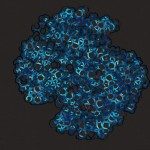Link to Pubmed [PMID] – 18188151
EMBO J. 2008 Jan;27(2):447-57
Type III secretion (T3S) systems are largely used by pathogenic gram-negative bacteria to inject multiple effectors into eukaryotic cells. Upon cell contact, these bacterial microinjection devices insert two T3S substrates into host cell membranes, forming a so-called ‘translocon’ that is required for targeting of type III effectors in the cell cytosol. Here, we show that secretion of the translocon component IpaC of invasive Shigella occurs at the level of one bacterial pole during cell invasion. Using IpaC fusions with green fluorescent protein variants (IpaCi), we show that the IpaC cytoplasmic pool localizes at an old or new bacterial pole, where secretion occurs upon T3S activation. Deletions in ipaC identified domains implicated in polar localization. Only polar IpaCi derivatives inhibited T3S, while IpaCi fusions with diffuse cytoplasmic localization had no detectable effect on T3S. Moreover, the deletions that abolished polar localization led to secretion defects when introduced in ipaC. These results indicate that cytoplasmic polar localization directs secretion of IpaC at the pole of Shigella, and may represent a mandatory step for T3S.


